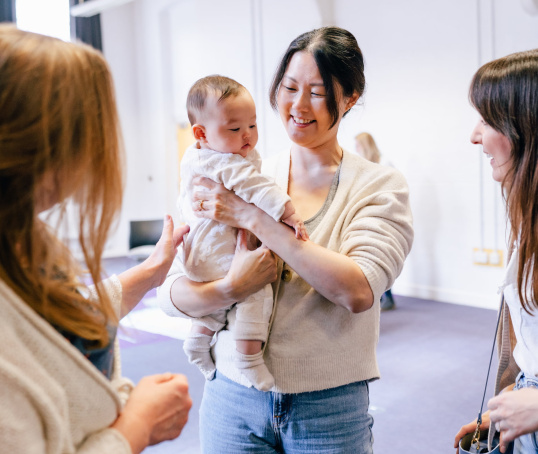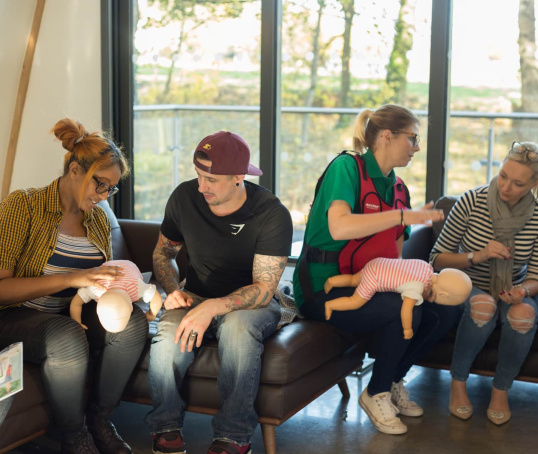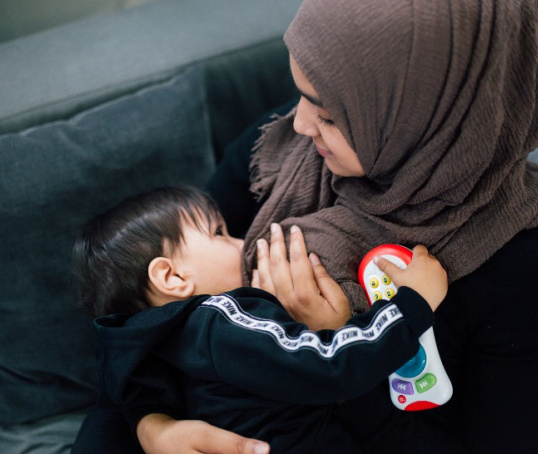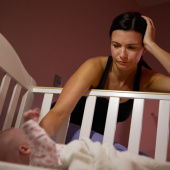Deciding whether to leave your baby to cry is a tough one. Here we look at crying extinction techniques, and the pros and cons for babies over six months.
'Cry it out' and 'controlled crying' are topics that can lead to passionate debate between parents (and the experts). The instinct to go to your baby if they’re upset can be overwhelming. But so can your frustration when they don’t settle – particularly if you’re exhausted. This is when some parents start thinking about sleep training techniques.
What are controlled crying and cry it out?
Once their baby is old enough (over six months [BASIS, no date a; Douglas and Hill, 2013]) and they're safe and secure, some parents decide to explore different sleeping techniques. This is a personal choice and will depend on different reasons and circumstances.
Cry it out and controlled crying are two forms of sleep training aimed at eliminating sleep problems. The other kinds of sleep training are about preventing problems from developing (BASIS, no date b). Cry it out means leaving the baby to cry and parents not responding to them at all. Controlled crying is when parents do check in on the baby to let them know they’re there, but do not respond to the crying or soothe the baby.
What is self-soothing?
Self-soothing means developing emotional self-regulation. This is a person’s ability to recognise and manage their own emotional responses.
Babies start to develop this understanding from around the age of six months (Murray, 2014). Babies can still experience distress if they are left to cry after this age though. And they do continue to need those caring for them to help ease their distress (Rothbart and Posner, 1985) in the same way that you sometimes need support and a cuddle.
Older babies learn over time to settle themselves, with caregivers gradually reducing the amount of support provided. But babies won’t be able to do that every time, and sometimes they will still need your support.
What does the evidence say?
Some babies begin to understand the 24-hour rhythm of day and night at around three months, while others will take longer. Their night-time sleep periods start to get longer but many will still wake and cry several times each night for months (Leach, 2015).
Young babies, in particular, are probably waking up because they need to feed, not because they are unable to self-soothe (BASIS, no date c).
Research maintains that sleep training under six months of age does not improve sleep outcome for babies or wellbeing for parents (Douglas and Hill, 2013). More recent research on sleep training is only on babies over six months old, because of concerns about the effect on younger babies. There is good evidence that sleep training methods can improve the parent’s mood or change how parents report their babies’ sleep patterns (BASIS, no date d).
There is little research that looks at the effects of sleep training on babies beyond the effect on their sleep (or crying) and whether there are any potential long-term effects on the baby’s wellbeing or development (BASIS, no date d).
What are the arguments for and against controlled crying or cry it out?
It can help to think through the pros and cons of sleep training for your baby over six months before deciding whether it’s right for you and your baby.
Pros of sleep training
- Some parents find that controlled crying or cry it out works relatively quickly, often within three weeks (Matthey and Črnčec, 2012).
- Some babies whose parents undertook sleep training of any kind around six months show better self-soothing at a year old (Early Intervention Foundation, 2018).
- Some research shows that babies with a settled bedtime routine had fewer behaviour problems as babies and toddlers (Mindell et al, 2015).
Cons of extinction (crying it out) methods
- Some people believe not responding to a baby’s cries at bedtime has become a part of a rigid Western cultural approach to child-rearing, which is not appropriate for every parent or baby(Maute et al, 2018).
- Some research suggests that not attending to the child if they’re upset affects secure attachment and the ability to regulate feelings as an adult (Leach, 2015; Williams et al, 2016).
- Carrying out controlled crying or cry it out can be stressful. Some parents find it goes against all their instincts to repeatedly not pick their baby up if they appear to be upset (BASIS, no date a).
- Controlled crying and cry it out can create a lot of noise, and worrying about other family members or neighbours can add to stress levels (BASIS, no date a).
How do controlled crying and cry it out work?
Whichever method you're using, once you see your baby is getting tired, first make sure they have a clean nappy and are not hungry, thirsty or uncomfortable.
The cry it out method involves following Step 1 and Step 2, then ignoring your baby until you wish to feed, change, or wake them.
The controlled crying method involves taking the following steps.
Step 1: Put them in their cot, sleepy but still awake.
Step 2: Say goodnight and leave the room.
Step 3: If your baby cries, leave them for two minutes before going back to let them know they're ok. Settle them back down, say goodnight and leave the room.
Step 4: This time, wait for five minutes, before repeating the process again, adding a couple of minutes each time.
There are different views about how much to comfort your baby each time you go back to see them. These range from just speaking and reassuring to physical contact like stroking.
Are there any alternatives?
There are other more gradual methods of sleep training which might be gentler for babies and parents (Gradisar et al, 2016). For more information about these methods and others, have a look at our articles about sleep.
Is there anything else I need to think about?
The decision to try sleep training is a personal one for every parent. You might feel that the benefits, for both your baby and you, outweigh any worries; or you might decide that a different approach works better for you.
Also keep in mind that some parents might start controlled crying or cry it out and then find it too stressful to continue or that it's just not working as they'd hoped. We know that any method can work for some babies but not for others.
The good news is that there is a lot of support and information to help you figure out what works for you and your baby. Talk it through with your partner, family, friends and other parents. Some parents find talking about sleep training options with their health visitor a useful source of information and support.
This page was last reviewed in April 2022.
Further information
Our support line offers practical and emotional support with feeding your baby and general enquiries for parents, members and volunteers: 0333 252 5051.
You might find attending one of our NCT New Baby groups helpful as they give you the opportunity to explore different approaches to important parenting issues with a qualified group leader and other new parents in your area.
Make friends with other parents-to-be and new parents in your local area for support and friendship by seeing what NCT activities are happening nearby.
Watch our coping with crying film.
Understanding Childhood also have a range of resources available online and to download, developed by child psychotherapists, including a leaflet on crying.
There’s also useful information on soothing a crying baby on the NHS website.
The NSPCC helpline provides help and support to thousands of parents and families.
Learn more about babies sleep at BASIS infant sleep.
The Lullaby Trust has lots of useful information and support for parents about safe sleep.
BASIS. (no date a) Things to consider – potential costs of sleep training. Available at: https://www.basisonline.org.uk/things-to-consider-potential-costs-of-sl… [accessed 21st March 2022]
BASIS. (no date b) Sleep training research. Available at: https://www.basisonline.org.uk/sleep-training-research/ [accessed 19th March 2022]
BASIS. (no date c) Why babies sleep as they do. Available at: https://www.basisonline.org.uk/why-babies-sleep-as-they-do/ [accessed 19th March 2022]
BASIS. (no date d) Limitations of sleep training research. Available at: https://www.basisonline.org.uk/hcp-limitations-of-sleep-training-resear… [accessed 21st March 2022]
Douglas PS, Hill PS. (2013) Behavioral sleep interventions in the first six months of life do not improve outcomes for mothers or infants: a systematic review. J Dev Behav Pediatr. 34(7):497-507. Available at: http://doi.org/10.1097/DBP.0b013e31829cafa6
Early Intervention Foundation. (2018) What works to enhance the effectiveness of the Healthy Child Programme: An evidence update. Available at: https://www.eif.org.uk/files/pdf/what-works-to-enhance-effectiveness-healthy-child.pdf [accessed 21st March 2022]
Gradisar M, Jackson K, Spurrier NJ, Gibson J, Whitham J, Williams AS, et al. (2016) Behavioural interventions for infant sleep problems: A randomised controlled trial. Pediatrics. 137(6). pii: e20151486. Available at: https://doi.org/10.1542/peds.2015-1486
Leach P. (2015) Controlled crying: What parents need to know. Int J Birth Parent Education. 2(4):13-17. Available at: https://ijbpe.com/journals/volume-2/20-vol-1-issue-4
Matthey S, Črnčec R. (2012) Comparison of two strategies to improve infant sleep problems, and associated impacts on maternal experience, mood and infant emotional health: a single case replication design study. Early Hum Dev. 88(6):437-42. Available at: https://doi.org/10.1016/j.earlhumdev.2011.10.010
Maute M, Perren S. (2018) Ignoring children’s bedtime crying: the power of Western-oriented beliefs. Infant Ment Health J. 39(2):220-230. Available at: https://doi.org/10.1002/imhj.21700
Mindell JA, Li AM, Sadeh A, Kwon R, Goh DY. (2015) Bedtime routines for young children: a dose-dependent association with sleep outcomes. Sleep. 38(5):717-722. Available at: https://doi.org/10.5665/sleep.4662
Murray L. (2014) The Psychology of Babies. Constable & Robinson, London.
Rothbart MK, Posner MI. (1985) Temperament and the development of self-regulation. In: Hartlage LC, Telzrom CF.(1985) The Neuro-psychology of Individual Differences: A Developmental Perspective. Plenum Press, New York.
Williams CJ, Kessler D, Fernyhough C, Lewis G, Pearson RM. (2016) The association between maternal-reported responses to infant crying at 4 weeks and 6 months and offspring depression at 18: a longitudinal study. Arch Womens Ment Health. 19(2):401-408. Available at: https://doi.org/10.1007/s00737-015-0592-2







